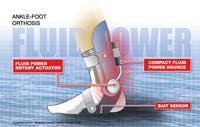The demands of designing wearable medical and human assist devices are pushing the limits of miniaturization of fluid power systems. Because of its superior power-to-weight ratio, fluid power is ideal for applications like orthoses, where space and weight are at a premium.
Select image enlarge.
Since 2006, the Center for Compact and Efficient Fluid Power (CCEFP) has been bringing together industry, research, and education to transform fluid power technology. The Center will be undergoing an audit by the National Science Foundation this month as its seeks to renew its funding for another five years. Such funding supports the Center’s 22 research projects and five test beds, which focus primarily on efficiency, compactness, and effectiveness. The following case studies highlight two of the ongoing research projects by educators and researchers at the University of Minnesota, one of the CCEFP’s affiliate colleges.
Air compressor puts its foot forward
Assisting individuals with temporary or permanent mobility impairments is the goal of Professors Will Durfee and David Kittelson and Ph.D. student Lei Tian. The team is developing a mini air compressor that powers an untethered ankle orthosis. The air compressor is powered by a tiny hydrocarbon fueled internal combustion engine. Both engine and compressor are integrated into a single free-piston unit. According to Durfee, “The engine uses HCCI (homogeneous charge compression ignition) combustion and a free piston. The engine bore will be between 3 and 5 mm, which means that the engine size for our target output power of 20 W will be about 5-cm long.”
The work is based on a project started by Hans Achelmeyer, a former Ph.D. student with Professor Kittelson, who is now a member of the CCEFP Scientific Advisory Board.
An ankle orthosis may be temporarily required by an athlete with a ligament tear or someone just coming out of arthroscopic surgery. Permanent impairment would include post-stroke patients who have foot-drop. In all cases it would be considered an assistive device.
Currently, all existing ankle foot orthoses (AFO) are non-powered. All powered orthotics for any joint — including powered AFOs exoskeletons — are all in the research and development phase.
The power density and compactness of fluid power is ideal for wearable equipment that needs to be strong, but still small and light, says Durfee. “Sizes take us into the realm of tiny hydraulics and pneumatics because nobody wants to wear a 10-lb traditional hydraulic cylinder on their foot,” he adds.
Research began last September, and the team is still in the beginning phases of conducting the mathematical simulations to optimize engine details, including the size and shape of the combustion chamber, the valving to let a fresh fuel charge in and the exhaust out, and a bounce chamber so that the engine cycles. Durfee says clinical trials are 5 years away, with future product release 10 years away.
Propelling automotive drive trains into the future
If there are two things any automotive manufacturer needs to do in the near future, they would be applications. “If successful, the freepiston engine pump/motor system can replace the conventional power train in a vehicle,” Sun says. “Our target is to develop a flexible power train system that is clean, efficient, and capable of alternative fuels.”
The main components include a free-piston engine and a linear hydraulic motor/pump. The size will depend on the specific application, but should range from 10 to 100 Kw. The maximum pressure is between 3000 to 5000 psi.
The free-piston engine converts liquid fuel, including alternative fuels, into linear mechanical motion, which is then converted into high-pressure fluid through the hydraulic pump. The free-piston engine employs an electrohydraulic camless valve train and a high-speed direct fuel injection system enabled by the high-pressure fluid system.
The proposed system offers three key advantages. First, energy conversion efficiency is greatly improved over conventional internal combustion engines due to the flexible valve train, fuel injection system, and variable compression ratio. Second, the linear hydraulic pump/motor offers both high power density and high efficiency. Third, the output power can be adjusted quickly in real time due to the engine’s flexibility and the high power density of the fluid, which is a truly ondemand system without a large energy storage device. This system requires special modeling and control techniques for its operation, namely the coordination of the combustion event with the power transmission of the hydraulic system.
This research, which also is in the beginning phases, will require about three years, Sun says.
For information, visit www.ccefp.org


